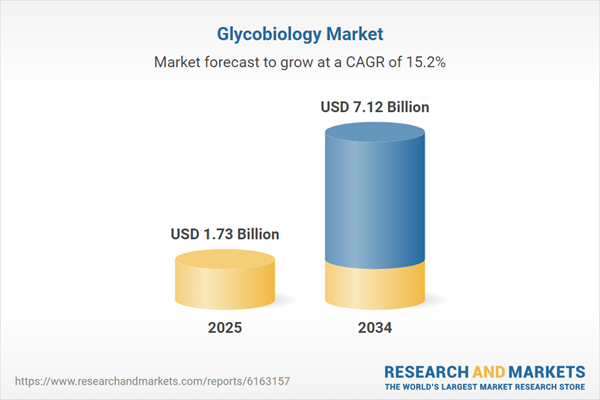Glycobiology: Introduction
Glycobiology is an area of study in which carbohydrates are studied that are also known as glycans. The carbohydrates and their role in different biological processes are studied in glycobiology. It is the study about the structure, functionality, and communications of glycan with lipids and other molecules present in living organisms. Carbohydrates play an important role in several biological processes such as cell-to-cell interaction, disease progression, and many others. In Glycobiology the role of carbohydrates in these processes is studies and how they can be used for treatments in various conditions as well.Global Glycobiology Market Analysis
The primary trend aiding the global glycobiology market growth is the increasing focus of researchers on exploring the potential of glycans for treatment applications in healthcare industry. The therapeutic applications of glycans may include glycoconjugate vaccines, in order to treat diseases. The increasing focus on exploring therapeutic applications of glycans is a major trend in the market.Additionally, the use of mass spectrometry and high-performance liquid chromatography has increased in order to characterize glycome of biological fluids, tissues, and cells. Glycobiology is slowly drifting towards exploring the functional efficiency of glycans from just studying the glycan structures.
Glycobiology plays a significant role in the development of personalized medicine, as glycans are involved in disease progression, drug response, and patient stratification. The increasing focus on developing personalized medicine is driving the demand for glycobiology research and diagnostic tools in the market. The increasing research and development activities in the field of glycobiology which is driven by the escalating comprehension of the role of glycans in various biological processes. This trend is leading to the discovery of new glycan-based biomarkers and therapeutic targets.
Global Glycobiology Market Segmentations
The report titled “Glycobiology Market Report and Forecast 2025-2034 offers a detailed analysis of the market based on the following segments:Market Breakup by Product
- Enzymes
- Instruments
- Reagents
- Kits
Market Breakup by Application
- Drug Discovery and Development
- Disease Diagnostics
- Virology
- Cell Biology
- Oncology
- Others
Market Breakup by End User
- Research Institutes
- Diagnostic Centers
- Hospitals
- Clinical Laboratories
- Pharmaceutical and Biotechnology Companies
- Others
Market Breakup by Region
- North America
- Europe
- Asia Pacific
- Latin America
- Middle East and Africa
Global Glycobiology Market Overview
The increasing interest in studies of glycans (carbohydrates) along with their benefits in biological systems is a major factor aiding the global glycobiology market development. The study of glycans has gathered comparatively more attention in past few years. The market for research of glycobiology and its applications is encountering stable growth and is expected to continue growing in the coming years.Additionally, the increasing understanding of glycans and its importance in various biological processes and diseases is a major factor driving the glycobiology market expansion. There is a vital role that glycans play in cell-cell communication, immune response, protein folding and stability, and several other biological functions. As researchers reveal more information about the complex interactions between glycans and proteins, there is a growing demand for tools, technologies, and expertise in glycobiology.
In conclusion, the glycobiology market is witnessing growth due to the elevating recognition of the existence of glycans in biology and disease, the demand for equipment and technologies to study and alter glycans, and the potential uses of glycobiology in healthcare and pharmaceutical industries. The market is expected to continue expanding as research in glycobiology improves and more applications are found.
Glycobiology Market: Competitor Landscape
The key features of the market report include patent analysis, grants analysis, clinical trials analysis, funding and investment analysis, partnerships, and collaborations analysis by the leading key players. The major companies in the market are as follows:- Merck KGaA
- Thermo Fisher Scientific Inc.
- Shimadzu Corporation
- Takara Bio Inc.
- Promega Corporation
- Danaher Corporation
- AMS Bio
- Sumitomo Bakelite Co. Ltd.
- Dextra Laboratories Ltd.
- RayBiotech, Inc.
- Waters Corporation
- Glycotope GmbH
- New England Biolabs, Inc.
This product will be delivered within 3-5 business days.
Table of Contents
Companies Mentioned
- Merck KGaA
- Thermo Fisher Scientific Inc.
- Shimadzu Corporation
- Takara Bio Inc.
- Promega Corporation
- Danaher Corporation
- AMS Bio
- Sumitomo Bakelite Co. Ltd.
- Dextra Laboratories Ltd.
- RayBiotech, Inc.
- Waters Corporation
- Glycotope GmbH
- New England Biolabs, Inc.
Table Information
| Report Attribute | Details |
|---|---|
| No. of Pages | 350 |
| Published | July 2025 |
| Forecast Period | 2025 - 2034 |
| Estimated Market Value ( USD | $ 1.73 Billion |
| Forecasted Market Value ( USD | $ 7.12 Billion |
| Compound Annual Growth Rate | 15.2% |
| Regions Covered | Global |
| No. of Companies Mentioned | 13 |









